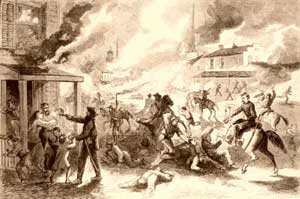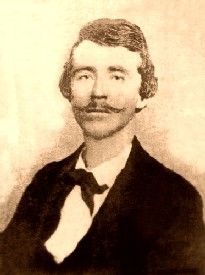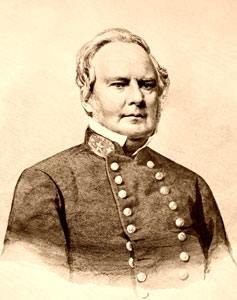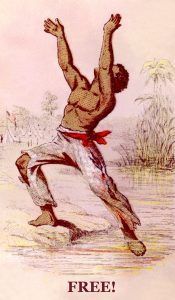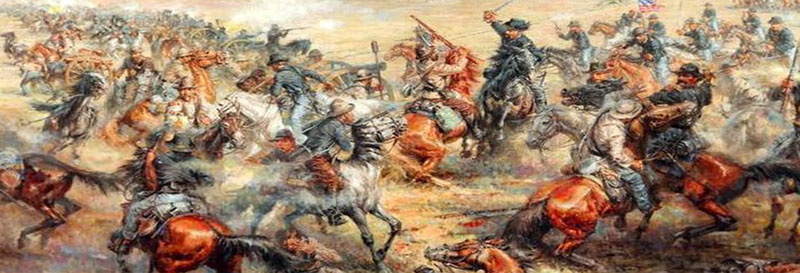
Civil War in Kansas.
Beginning of the Civil War. Just before Kansas was admitted to the Union, several southern states seceded. The trouble between the North and the South had reached the point where it could no longer be compromised. Other states seceded, and when Fort Sumter, South Carolina, was fired upon on April 12, 1861, the Civil War began.
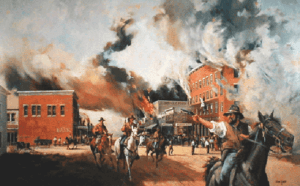
Bleeding Kansas
Part Taken by Kansas in the Civil War. A state that had just passed through nearly seven years of Territorial struggle closing with a famine would hardly be expected to participate in a great war. However, the Kansas people had been battling over the slavery question and, being deeply interested in the outcome, were ready to take up arms in defense of the principle of freedom. Every call for soldiers to defend the Union was liberally responded to in Kansas. This State furnished more soldiers in proportion to its population than any other State. During the four years of the war, Kansas furnished more than 20,000 men, nearly four thousand more than were asked for, and all were volunteers. The poverty in the Kansas homes made it especially hard for families to be left unprovided for, and as much honor is due to the women who stayed at home to work as to the men who marched away to fight. The Kansas soldiers did duty on many battlefields and conducted themselves to bring much credit to their State. During the war, Kansas was exposed to three lines of danger: invasions by the regular Confederate army, attacks by the unorganized border troops, and Indian raids on the frontier.
“A house divided against itself cannot stand.’ I believe this government cannot endure permanently half-slave and half-free. I do not expect the Union to be dissolved; I do not expect the house to fall, but I do expect it will cease to be divided.”
— Abraham Lincoln.
The Quantrill Raid, August 21, 1863. For Kansas people, the Civil War meant a continuation of the border troubles. Gangs of ruffians plundered and destroyed property and frequently committed worse crimes. These acts reached a climax in the destruction of Lawrence on August 21, 1863. The raid on Lawrence was led by William Quantrill, a border ruffian who had taken an active part in the guerrilla warfare and who, with his men, had sacked several smaller towns along the border. With about 450 mounted men, Quantrill crossed the border in the late afternoon of August 20 and proceeded toward Lawrence. Just before sunrise, the raiders reached a hill a mile from the town. Strangely, they could have made the ride of 40 miles through Kansas settlements without a word of warning reaching Lawrence, but such was the case. When Quantrill and his men halted within pistol shot of the houses of Lawrence to plan their attack, the people suspected no danger. There was no armed organization within the city, and all firearms were locked in the arsenal. The attack began with a wild charge on the town.
Horsemen rode through the streets at top speed, shooting in every direction. Then, they divided into small gangs and scattered over the town under orders to “burn every house and kill every man.” The horror of what followed has seldom been equaled in the warfare of civilized people. When the people of Lawrence realized that their town was in possession of Quantrill’s band, they expected it would be burned and a few prominent citizens killed, but wholesale murder was not looked for, and many who might have escaped remained and were killed. For four hours, the ruffians robbed buildings, shot the occupants, and applied the torch. Every house was a scene of brutality or remarkable escape.
When the work of butchery and destruction was finished, Quantrill and his men retreated toward Missouri, mounted on stolen horses and heavily laden with plunder. They kept up their work of destruction by burning farmhouses as they passed. A few troops followed them, but the raiders escaped across the border.
Loss from the Raid. The number of lives lost can never be known with certainty, but it was about 150. Many were seriously wounded. The loss of property was estimated to be from one to two million dollars. The work of rebuilding the town was immediately begun, and with all their poverty, the people of the State gave generously to the stricken citizens of Lawrence.
General Price Threatens Kansas. Kansas was too far away from the center of conflict of the Civil War to become the scene of significant battles, but it was, from time to time, threatened with invasion by the regular Confederate army. During the last year of the war, General Sterling Price, with a large Confederate force, marched northward through Arkansas into Missouri. When it was reported that he was moving westward, Kansas issued a call for more soldiers. The response was immediate. More than 16,000 men appeared for service. Kansas troops marched into Missouri and met Price’s army in battle at Lexington. As the armies moved westward, other battles were fought at the Little Blue and the Big Blue River and again at Kansas City and Westport, after which Price was forced to retreat southward. The Union army followed him. He crossed into Kansas in Linn County, and skirmishes occurred at Trading Post Ford, the Mounds, and Mine Creek. Price was then forced into Missouri again, where he was soon defeated.
End of the Civil War, 1865. In April 1865, the great war came to a close after lasting almost exactly four years. The questions of slavery and disunion were finally settled. The nation was thankful to lay down its arms and go back home “to drop the sword and grasp the plow,” but this was especially true of Kansas, where the people had been battling the slavery question for eleven years. The Territorial period and the Civil War period made one continuous conflict. With the heavy drain on resources and population, it was not to be expected that Kansas would make much growth or progress during the Civil War. The development could be little more than equal waste and loss. The population of Kansas numbered about 100,000 at the beginning of the war and about 136,000 at the close. There had been a slight improvement in living during the four years.
Summary. The Civil War began within three months of Kansas’s becoming a state. Although Kansas had had no opportunity to recover from the Territorial struggle, it took an active part in the war. General Price threatened to invade Kansas with a large Confederate force but failed.
The Indians committed depredations on the western frontier. The worst feature of the war was the border trouble, the climax of which was the Quantrill raid. During the four years of the Civil War, Kansas did not significantly gain in population or progress.
Compiled & edited by Kathy Alexander/Legends of America, updated March 2025. Source: Arnold, Anna E.; The State of Kansas; Imri Zumwalt, state printer, Topeka, Kansas, 1919.
Also See:
William Quantrill – Renegade Leader of the Missouri Border War

